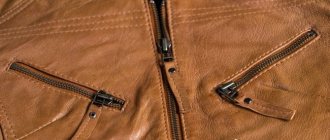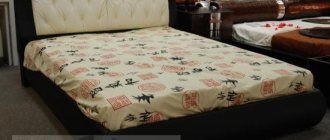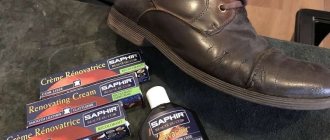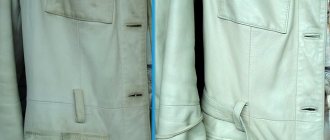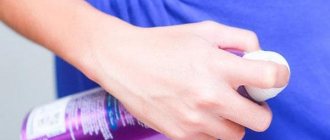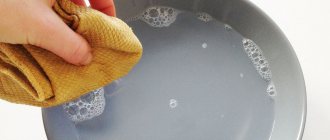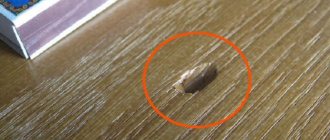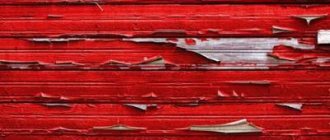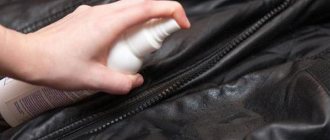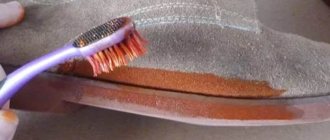Renewal of shine
The following will help restore the lost shine of a product:
- Whipped egg white. It is applied in a thin layer to the surface of the skin. After complete absorption, it acquires a bright shade, becomes softer and begins to shine.
- Lemon juice. Dissolve 5 ml of alcohol and a little juice in 1 liter of water. The product is treated with the composition and then wiped with a clean cloth. At the end, it is recommended to apply glycerin and dry the jacket in natural conditions, hanging it on hangers.
- Castor oil. The skin is cleaned with a soap solution with the addition of ammonia and wiped with castor oil.
- Coffee grounds. It is wrapped in a napkin, flannel or woolen fabric and the resulting tampon is used to treat the jacket.
When applying any of the available products to the skin, it is necessary to distribute it evenly and carefully over the surface, without missing any areas, so as not to spoil the appearance.
Removing cracks from skin
Many modern leather products have a nitro coating, which protects them from moisture and masks minor defects.
This film covers the surface of the skin and gives it shine. However, nitro coating has a drawback - its instability to bending. Because of this, cracks often appear on jackets and boots at the folds. Acetone will help deal with cracks. Small cracks or scratches are removed using a swab soaked in acetone. The work must be carried out quickly, with light pressure, without lingering in place, covering the entire surface of the product at once. Do not rub acetone into the skin. The top layer of nitro paint will be slightly washed out. This is enough to mask minor defects. Before completely treating the item with acetone, try cleaning a small, inconspicuous area. Remember that organic solvents should be used in well-ventilated areas, observing fire safety regulations.
Removing scratches and abrasions
If the clothing is worn out and the leather is damaged, it can be restored. Scratches on a jacket can be easily removed using the following methods:
- The damaged area is treated with baby cream or restorative wax, and after some time the scratch disappears.
- Rub with orange peel.
If deep tears and scratches appear, use liquid leather. This product is sold in stores. When using it, you must strictly follow the instructions.
There are several options for removing scuffs on a leather jacket:
- Problem areas are treated with shoe polish or paraffin.
- Use rubber glue, applying it to the skin with a clean and dry piece of cloth. After the product is completely dry, it is processed again.
An old leather jacket can be easily restored using a special product (liquid leather).
Repair of leather goods: types and features
The worst thing is if cuts appear on a leather product or if it gets caught on something, it is torn. You'll have to tinker a little. Depending on the type of damage, the skin can be sealed, a patch can be sewn on, or part of the product can be replaced by selecting the required piece based on color and size. It's easy to tape things up at home.
The second two types of repairs - patching and replacing the torn area - are best done in a workshop, where they will select the most suitable leather. In such cases, the repair will be carried out professionally and the product will remain just as beautiful.
- Minor damage can be sealed. To do this, it is better to use elastic glue “Moment”.
- In some cases, superglue is used to quickly seal the edges of the tear. But it is applied very carefully with a toothpick only to the edges of the skin.
- If glue accidentally drips onto the surface or a hard scar forms, the product will be damaged. An expensive replacement of its part by specialists will be required.
- Using elastic glue suitable for leather, glue the patch on the reverse side, carefully leveling the leather on top.
- The patch must be larger than the tear area in order to glue the torn piece to it.
For cosmetic repairs of small tears, cuts, cracks, ready-made liquid leather is used (for example, MAVI STEP or LIQUID LEATHER). This product is not always suitable for skin with a certain texture and relief.
It can only be used for smooth. The presence of a characteristic shine after drying of liquid leather will not allow it to be used for matte products. You will need to create a matte finish by lightly wiping the coated area with fine sandpaper. After a few months, the liquid leather will have to be reapplied as it wears off.
Removing dirt and salt stains
Dirt is easily removed from the surface of the material using a wet method. If a greasy stain appears, you should try glycerin oil or a colorless cream.
A frequently used method is to use purified gasoline or acetone. It is recommended to first test this method on an inconspicuous area of the product.
Salt stains are removed in the following ways:
- treat the contaminated area with vinegar;
- A mixture of ammonia, soap and formaldehyde (1:1:4) is used.
Cleaning a leather product
Begin the restoration by removing any remaining cream and stains. It's no secret that fresh stains are removed better and faster than old ones, so don't put off cleaning leather products for too long. To clean the surface, use a lint-free cloth swab soaked in burdock oil or turpentine. If dirty, take a new one. You can use an old, proven remedy - clean dirt from the leather surface with warm, unboiled milk. The fat contained in the milk will be absorbed into the skin, and will save you from the need to additionally fatten it after cleansing.
Color restoration
To renew a leather jacket at home, use products to restore leather color. Select paint of the same shade. When using an aerosol, proceed according to the following scheme:
- Degrease the surface and, hanging the jacket in a vertical position, evenly distribute the product from a distance of 20 cm.
- Excess paint is removed with a sponge.
- Leave the product to dry for 1.5-2 hours.
When using an aerosol, it is recommended to use respiratory protection.
The color can also be restored using powder paints. It is dissolved in water (2 l) and boiled for several minutes. Clothes are immersed in the composition at a temperature of +45°C. The coloring process takes place within 2-3 hours.
After this, the item is rinsed well several times and to consolidate the effect, treated with a solution of 1 liter of water, 1 cup of vinegar and 1 tbsp. l. salt. Dry the product naturally on hangers.
Ways to get rid of scratches
Removing mechanical damage - scratches and abrasions - requires care and special tools (both improvised and professional):
We recommend:
How to choose a pillow for sleeping - rating of fillers
- Orange peel. Whitish areas can be refreshed with citrus fruits. The best remedy is orange peel. With its outer side you need to carefully rub the defects.
- Glycerin solution. Glycerin diluted with water in equal proportions helps remove deep creases and small cracks. They need to treat the “wounds” without washing it off.
- Nail polish. A colorless nail polish can be used to seal small tears. You need to pour the varnish into the crack as carefully as possible (it’s convenient to use a toothpick) and press with your fingers for two to three minutes. You can also use instant glue.
- Liquid Leather. Special “liquid skin” for filling defects should be used according to the manufacturer’s instructions.
Important! When using adhesives, you need to prevent drops from appearing on the surface of the skin by choosing the right dosage.
Tips for care and storage
In order for the item to serve for a long time and maintain its appearance, it is necessary to use products that restore the structure of the leather, disinfect and give it shine.
Ingredients for regular product care:
- water repellent spray;
- conditioner for leather products;
- leather wax;
- soft sponge.
Following these recommendations will help maintain the appearance of your jacket:
- Hang clothes on hangers to prevent cracks and scuffs.
- Do not wash things in a washing machine.
- Dry clothes only at room temperature, away from heating devices.
- To store the product, purchase a special cotton bag with good ventilation.
If your clothes are heavily soiled or damaged and you cannot remove them yourself, you should take the item to the dry cleaner. Specialists will select an effective and safe remedy to eliminate the problem.
Preventing wear during storage
You need to start with wear prevention. When the product stretches or breaks due to improper storage, becomes dirty, hardens, cracks or abrasions form, much more effort and money will have to be spent on repairs. How to prevent rapid wear of leather products?
- Initially, they must be stored correctly. It is important to choose hangers.
- Since the weight of leather items is greater than the weight of ordinary fabrics, the hangers should not be thin so that the leather does not stretch.
- It is best to choose those that resemble the shape of your back.
- Products should not be stored in polyethylene and cellophane bags, which interfere with air circulation.
Jackets, raincoats and other leather clothing should be hung on strong, properly selected hangers in cotton bags or specially purchased cases in which there is access to air.
There are times when leather products need to be ironed. This is done very carefully only from the wrong side and through the fabric. The temperature on the iron should be low, approximately the same as required for ironing wool.
What to use to repair tears
It is possible to repair a leather jacket with your own hands, but it is necessary to adequately assess the risks. When there is a possibility of damaging the product even more, and it is expensive for a person, the best solution would be to contact a workshop with craftsmen who have experience working with leather, who will repair a jacket made of natural material quickly and without negative consequences for the item of outerwear.
But, if you have confidence in your abilities, before starting the repair you need to prepare all the consumables and tools that may be needed during the restoration of a leather outerwear item. The basic set of tools and consumables that will be needed when repairing a jacket when the leather has burst or a hole has formed by accident:
- art or paint brush;
- sewing needles;
- leather glue;
- tweezers;
- scotch;
- sewing threads of the appropriate color;
- leather dye;
- material that can be used as a patch;
- degreaser.
The items listed may potentially be needed when working with leather. When the damage is minor, there is an option that only glue will be enough, but more often you need to sew up the holes in the jacket using a patch. It is recommended to prepare the entire list of materials and tools, since during work it is not advisable to be distracted by searching - it is better when every necessary item is immediately at hand.
How to update a leather jacket
The procedure does not require much effort. But in order to restore a leather jacket and not spoil it, you should follow the recommendations of specialists.
Renewal of shine
The following will help restore the lost shine of a product:
- Whipped egg white. It is applied in a thin layer to the surface of the skin. After complete absorption, it acquires a bright shade, becomes softer and begins to shine.
- Lemon juice. Dissolve 5 ml of alcohol and a little juice in 1 liter of water. The product is treated with the composition and then wiped with a clean cloth. At the end, it is recommended to apply glycerin and dry the jacket in natural conditions, hanging it on hangers.
- Castor oil. The skin is cleaned with a soap solution with the addition of ammonia and wiped with castor oil.
- Coffee grounds. It is wrapped in a napkin, flannel or woolen fabric and the resulting tampon is used to treat the jacket.
When applying any of the available products to the skin, it is necessary to distribute it evenly and carefully over the surface, without missing any areas, so as not to spoil the appearance.
Removing scratches and abrasions
If the clothing is worn out and the leather is damaged, it can be restored. Scratches on a jacket can be easily removed using the following methods:
- The damaged area is treated with baby cream or restorative wax, and after some time the scratch disappears.
- Rub with orange peel.
If deep tears and scratches appear, use liquid leather. This product is sold in stores. When using it, you must strictly follow the instructions.
There are several options for removing scuffs on a leather jacket:
- Problem areas are treated with shoe polish or paraffin.
- Use rubber glue, applying it to the skin with a clean and dry piece of cloth. After the product is completely dry, it is processed again.
An old leather jacket can be easily restored using a special product (liquid leather).
Removing dirt and salt stains
Dirt is easily removed from the surface of the material using a wet method. If a greasy stain appears, you should try glycerin oil or a colorless cream.
A frequently used method is to use purified gasoline or acetone. It is recommended to first test this method on an inconspicuous area of the product.
Salt stains are removed in the following ways:
- treat the contaminated area with vinegar;
- A mixture of ammonia, soap and formaldehyde (1:1:4) is used.
Restoring skin elasticity
Fat-based components will help restore the product to its original appearance, soften and refresh the skin:
- Egg white is mixed with 3 tbsp. l. castor oil and apply the composition to the item.
- Dissolve 100 g of laundry soap, 5 ml of fish oil and 20 ml of ammonia in 1 liter of water. Surface treatment is carried out.
- After wiping the jacket with acetone, lubricate it with glycerin.
Odor removal
When restoring leather products, citrus peel is often used. It effectively eliminates unpleasant odors.
Cleaning the lining
The lining of a leather jacket should be carefully pulled back, placed in water and washed. In this case, you must try to avoid getting the soap solution on the leather base. The detergent can be removed with a soft sponge and blot the material with a dry cloth or towel.
Color restoration
To renew a leather jacket at home, use products to restore leather color. Select paint of the same shade.
When using an aerosol, proceed according to the following scheme:
- Degrease the surface and, hanging the jacket in a vertical position, evenly distribute the product from a distance of 20 cm.
- Excess paint is removed with a sponge.
- Leave the product to dry for 1.5-2 hours.
When using an aerosol, it is recommended to use respiratory protection.
The color can also be restored using powder paints. It is dissolved in water (2 l) and boiled for several minutes. Clothes are immersed in the composition at a temperature of +45°C. The coloring process takes place within 2-3 hours.
After this, the item is rinsed well several times and, to consolidate the effect, treated with a solution of 1 liter of water, 1 cup of vinegar and 1 tbsp. l. salt. Dry the product naturally on hangers.
